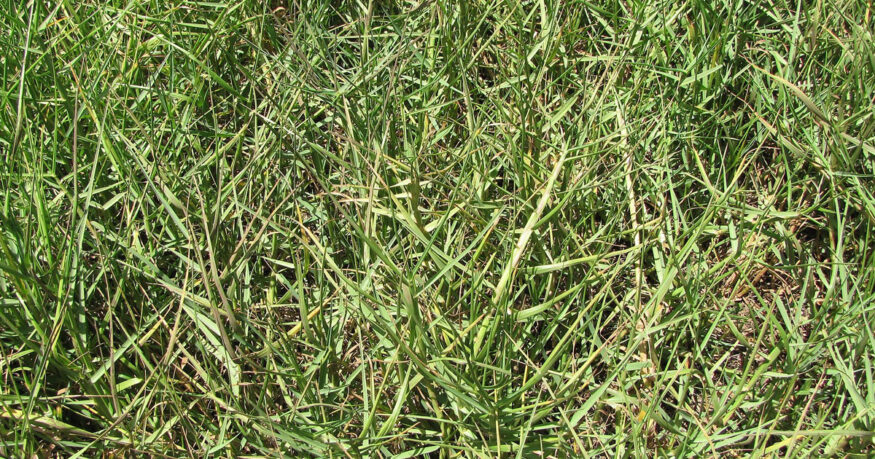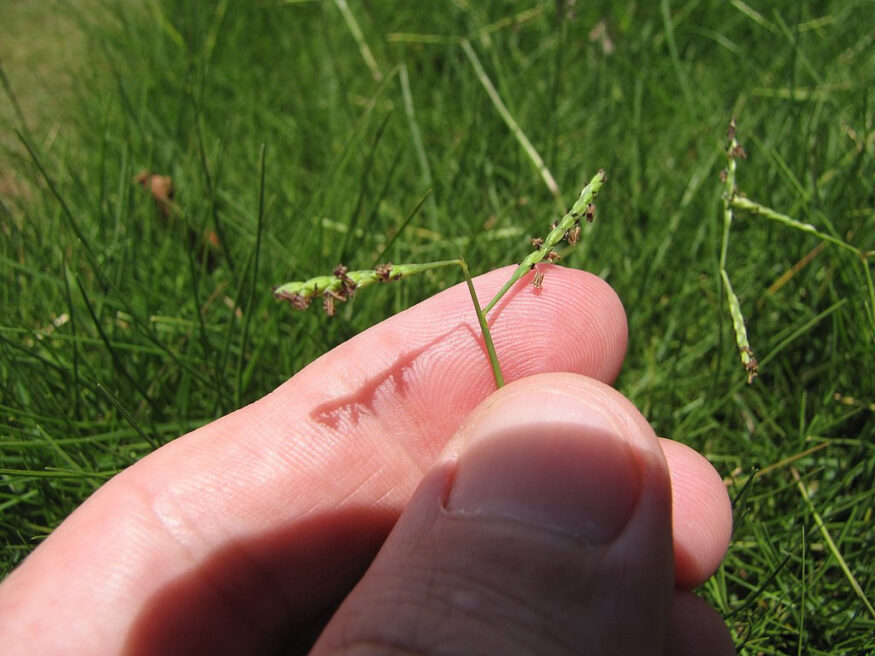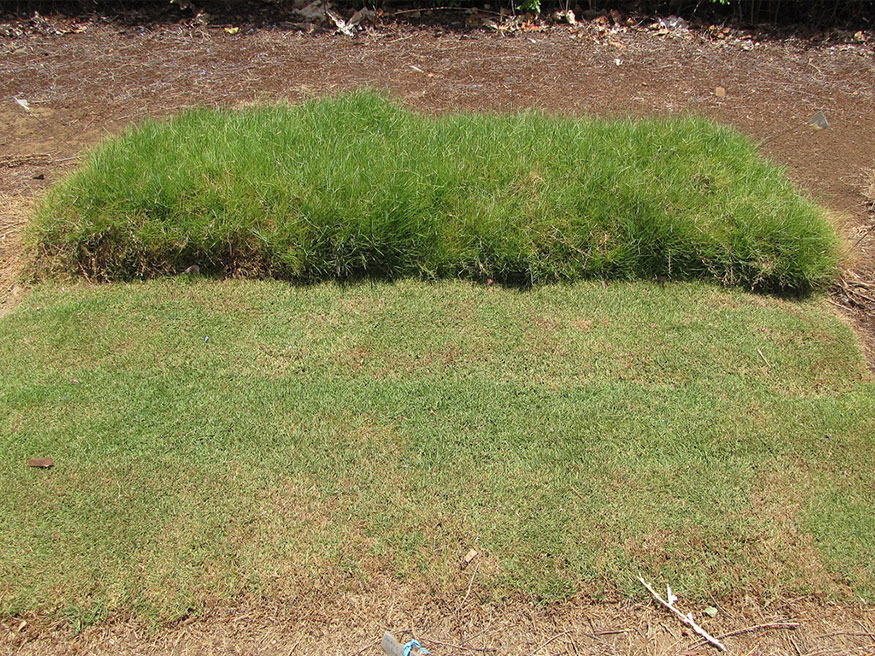Seashore paspalum grass is the perfect lawn solution for homes on the coast. It can tolerate saltier soil and wetter conditions than any other turfgrass species. But its low tolerance for cold limits its use.
In this guide, we’ll look at important seashore paspalum grass characteristics to help you determine if it’s right for your yard. We’ll also tell you everything you need to know to care for this warm-season grass using our helpful lawn care calendar.

Seashore Paspalum Grass Overview
| Also Known As | Biscuit grass, saltwater couch, silt grass, swamp couch; Paspalum vaginatum |
| Type of Grass | Warm season perennial |
| Optimal Zones | Subtropical coastal |
| Root Structure | Moderately deep |
| Winter hardiness | Very poor |
| Heat tolerance | Good |
| Shade tolerance | Good |
| Water Requirements | Moderate |
| Drought Tolerance | Moderate |
| Self Repair Capacity | Good |
| Overall Maintenance Requirements | Moderate |
The History of Paspalum vaginatum
Seashore paspalum likely originated in the Americas. It grows naturally in coastal regions throughout subtropical and tropical zones. But it wasn’t used as turf grass until the late 20th century.
As the need for water conservation increased in many areas, the benefits of using seashore paspalum began to outweigh its disadvantages. This grass has the unique ability to survive in high-salt environments. Not only can it be irrigated with gray water, but it can survive when irrigated with salt water.
This characteristic along with its ability to grow better in shade and survive wet soil make it a better choice than bermudagrass in some environments. Many cultivators of seashore paspalum have been bred for use on golf courses. It is also becoming more common for home lawn use.
While this hardy grass can survive poor conditions, it looks best when maintained correctly. Even still, it doesn’t require a lot of work and is a good choice for homeowners on the coast in hot and subtropical climates.
Seashore Paspalum Grass Characteristics

Seashore paspalum can survive less than desirable conditions, but it is not cold tolerant and is susceptible to many diseases.
To help you decide if seashore paspalum grass is right for your yard, let’s take a closer look at the characteristics of this species.
Type of Grass
Seashore paspalum is a perennial warm-season grass. “Perennial” meaning it comes back every year. And “warm season” meaning it does most of its growing when temperatures are hot.
In subtropical climates, it goes dormant in the winter but comes back sooner than most warm-season grasses.
Optimal Zones
Seashore paspalum does best in subtropical and tropical climates that do not see long periods below freezing in the winter. It is used most often in areas where bermudagrass cannot survive. This includes high saline environments, waterlogged areas, shady lawns, and areas where water use is restricted.
Turf Root Structure
The roots of seashore paspalum are fairly deep. It spreads via stolon and rhizome activity and can grow very quickly under the right conditions.
Winter Hardiness
The biggest weakness of this grass is the cold. It can survive temperatures under 32 degrees but will succumb in prolonged freezing temperatures.
It will go dormant when nighttime temperatures drop below 60 degrees. But, compared to other warm-season grasses, it comes back sooner in the spring.
Heat Tolerance
Seashore paspalum prefers consistent warmth but it does not thrive at high temperatures. It is adapted to humid, cloudy environments rather than scorching, sunny environments.
Shade Tolerance
Seashore paspalum is generally considered to have a better shade tolerance than even St. Augustine grass. It will grow very well under cloudy conditions and some varieties can be used in partial shade.
Water Requirements & Drought Tolerance
This unique grass does better with more water than with less. Compared to other warm-season grasses, it needs about ½ inch more water per week. It can tolerate soggy soil and even standing water.
While it grows best using potable water, it can be irrigated with non-potable water and salt water.
In times of drought, seashore paspalum is better able to survive than St. Augustine and centipede grass. But it has a lower drought tolerance than bermudagrass and zoysia grass.
Self Repair Capacity
Seashore paspalum has a good traffic tolerance and a moderate self-repair capacity. How quickly it comes back after damage depends on how well its growth needs are being met.
Seashore Paspalum Grass Lawn Care Calendar

Seashore paspalum is not a high-maintenance grass, but it does have some unique care needs that homeowners should know about
New lawns are typically established using sod, sprigs, or stolons. Currently, Seaspray is the only variety of seashore paspalum available in seed. Propagation in any form should be done in spring after the risk of frost has passed.
Brand-new lawns take time to establish. Once roots have grown and the grass is well anchored, you can begin following our seashore paspalum grass lawn maintenance plan, below.
Spring Care
Seashore paspalum will begin to green up and start growing in early to mid-spring. In tropical climates, it will grow all year long.
Mowing
Home lawns should be maintained at ½ to 2 inches in height. The optimal height for seashore paspalum is between ½ and 1 inch. However, a reel mower is required for heights this low.
A rotary mower can be used at heights over 1 ½ inches. But higher heights can lead to greater thatch buildup.
Mow often enough to avoid removing more than ⅓ of the grass blade during mowing. This will generally be about once per week during the spring.
Fertilization
Seashore paspalum requires 2 to 8 pounds of nitrogen per 1,000 square feet per year depending on how long your growing season is. Grass in northern Florida will only need about 2 pounds per year while grass in Hawai’i will require closer to 8 pounds per year.
Fertilization should be done in equal increments throughout the growing season, up to 1 pound per 1000 square feet per treatment. Slow-release fertilizer should be applied every 60 days. Quick-release fertilizer will require more frequent applications, every 30 to 45 days.
Start fertilizing in spring as soon as the grass has greened up completely and the threat of frost has passed.
A soil test done in the spring can help you determine what other nutrients are lacking. Seashore paspalum is very tolerant of a range of pH levels and nutrient deficiencies but grows best when optimal phosphorus, iron, and nitrogen levels are achieved.
Weed Control
Many weed control products will damage seashore paspalum. Only products labeled as safe for home use on seashore paspalum lawns should be used.
Targeted weed control is the safest way to address weeds that cannot be pulled by hand.
Watering
Irrigation is generally not needed in spring assuming at least 1 inch of rainfall per week. When supplemental watering is needed, the grass will tell you by folding over.
When this happens, apply ½ inch of water at a time. You typically will not have to do this more than twice per week.
Pest and Disease Control
Seashore paspalum is highly susceptible to fall armyworms and sod webworms. Use insecticide to control when damage becomes apparent.
This type of grass is very susceptible to many funguses, including:
- Dollar spot
- Leaf spot
- Fairy rings
- Fusarium blight
- Take-all spot
Overwatering, underwatering, over-fertilizing, and scalping are the most common causes of disease problems in seashore paspalum. You can generally avoid problems by watering deeply in the mornings only when grass shows signs of stress. Mowing frequently to an appropriate height with a sharp blade will help avoid scalping the grass.
If your lawn shows signs of any of these problems, treat it with an appropriate fungicide as needed. Assure the product you choose is safe for seashore paspalum.
Aeration and Dethatching
Spring is the best time to have your lawn aerated to avoid compact soil. Aerated soil is better able to accept nutrients and water. It will also help control thatch buildup and reduce disease incidence.
Seashore paspalum grass is prone to thatch buildup especially when left to grow to longer lengths. Once thatch gets over ½ inch in height, use a dethatcher with 2 to 3-inch blade spacings to remove it. Narrower spacings will damage the lawn.
Summer Care
Summer is when seashore paspalum grows the most. It will need careful watering, fertilizing, and mowing to thrive.
Mowing
Set your mower height between ½ and 2 inches for the summer. You can typically get away with shorter heights early on but should aim for closer to 2 inches during the heat of the season. This will help reduce stress and protect the root system.
Seashore paspalum growing in shade will perform better if left at 2 inches all summer long.
This grass can grow very rapidly this time of year. Mow as often as needed to avoid taking more than ⅓ of the leaf height off at a time.
As always, be sure to keep a sharp blade on your mower for the best results.
Fertilization
Continue fertilizing at the rate established in spring. For slow-release formulas, apply every 60 days. For quick-release products, apply every 30 to 45 days. Add phosphorus as determined by your soil test.
Watering
Only water seashore paspalum grass when it shows signs of stress. The leaves will curl slightly and the turf won’t bounce back from pressure.
When this happens apply ½ to ¾ inch of water in a single watering. Early morning is the best time to do this.
In periods of no rainfall, you will likely have to water twice per week. But it’s best to let the grass tell you when conditions are too dry.
Weed Control
Continue to use safe spot treatments and manual weed pulling to control weed problems.
Pest and Disease Control
Continue monitoring for signs of worm damage and treat as needed.
Keep an eye out for fungus problems and avoid stressing the lawn through poor maintenance. Continuing fungus problems in the summer are generally a sign that the grass is not being allowed to dry enough between waterings or that damage is being done during mowing.
Water only in the early mornings and only when grass shows signs of stress. Use a sharp blade on your mower and keep the grass trimmed under 2 inches. Never take more than ⅓ of the leaf height off in a single mowing.
Repair
Bare spots in lawns should be addressed in early summer by planting plugs or sprigs as needed. Some varieties can also be put in at the end of summer.
Fall/Autumn Care
Depending on where you live, fall will be about preparing your grass for winter dormancy or continuing maintenance for year-round growth.
Mowing
As summer temperatures cool, adjust your mowing height to between ½ and 1 inch if using a reel mower. This transition should be gradual to avoid taking off too much leaf at once. If using a rotary mower, keep the height between 1 ½ and 2 inches.
For colder climates, adjust mower height up ½ inch as cool weather approaches to add more leaf density before winter.
As usual, make sure your blade is very sharp to avoid leaf damage.
Fertilization
For year-long growth in warm climates, continue fertilizing following the schedule you set in spring.
For cooler climates, begin using a slow-release, balanced (equal parts nitrogen, phosphorus, and potassium) blend fertilizer this time of year. Apply once in early September and again in early November.
While winterizer fertilizer can be helpful for cool-season lawns, it is not recommended for seashore paspalum grass in most cases.
Weed Control
Continue treating weeds as you did in summer and spring. Annual grasses may become an issue in the colder months. Treat only with an herbicide safe for use on seashore paspalum.
Watering
Irrigation is generally not needed in the fall. However, if there is not much rainfall, you may need to supplement as you did through the summer.
For colder climates, seashore paspalum will go dormant when nighttime temperatures get below 60 degrees. Once fully brown, monitor moisture levels and water up to 3/4 inch at a time every 2 weeks only if needed.
Aeration and Dethatching
If aeration and dethatching were not done in the spring, they should be done in early fall while growth is still going strong. If you struggled with fungus problems in the summer, you may need to dethatch again even if it was done in spring.
Disease Control
Keep an eye out for fungus problems this time of year. Large patch, especially, can spread rapidly in moist, cool conditions. Treat with fungicides as needed.
Overseeding
It is possible to overseed your lawn with cool-season grasses when growing seashore paspalum. It requires the same preparation as zoysia and is much more work than overseeding bermudagrass. But it can be worth the work to get green grass all year long.
To find out how to overseed warm-season grasses, click here.
Overseeding is not necessary in warm climates where seashore paspalum grows all year long.
Winter Care
In cooler climates, seashore paspalum will be dormant through the winter. The only maintenance required is to make sure it receives enough water to survive until spring.
In warm climates, maintenance will continue as usual to assure proper growth.
Watering
For colder climates, continue monitoring moisture accumulation through the winter. If more than 3 weeks pass without precipitation, apply ¾ inch of water as soon as daytime temperatures get above freezing.
For grass that is not dormant, continue irrigating only when grass shows signs of stress.
Mowing
Continue to mow as often as needed to maintain a lawn height between ½ inch and 2 inches.
Fertilization
Continue with your established fertilization schedule throughout the winter as long as the grass is growing.
Weed Control
Continue treating weeds as you have been all year long. Annual grasses may become an issue in the colder months. Treat only with an herbicide safe for use on seashore paspalum.
Disease Control
Keep an eye out for fungus problems through the wet winter months. Large patch, especially, can spread rapidly this time of year. Treat with fungicides as needed.